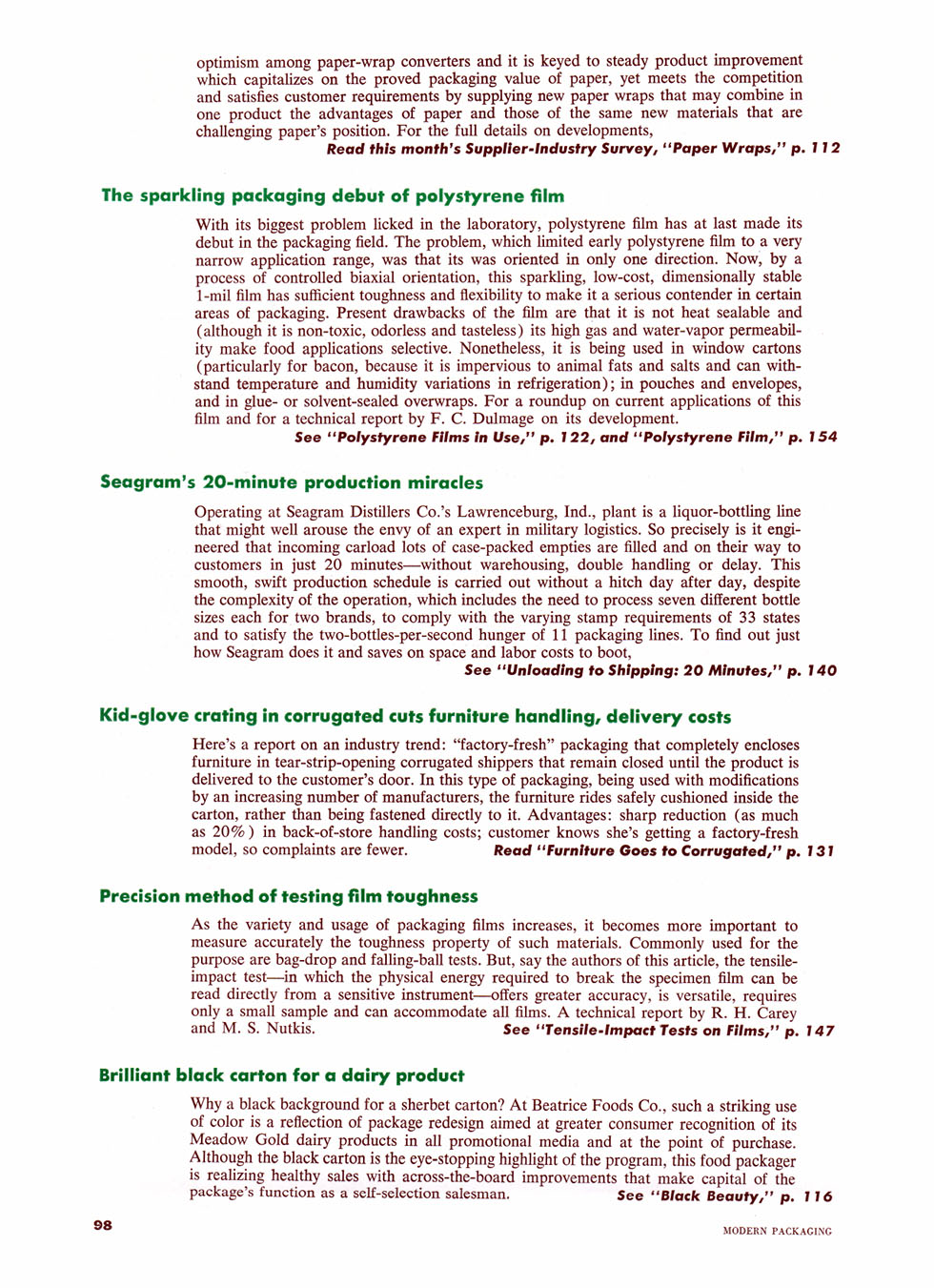


optimism among paper-wrap converters and it is keyed to steady product improvement which capitalizes on the proved packaging value of paper, yet meets the competition and satisfies customer requirements by supplying new paper wraps that may combine in one product the advantages of paper and those of the same new materials that are challenging paper's position. For the full details on developments,
Read this month's Supplier-Industry Survey, "Paper Wraps/' p, 112
The sparkling packaging debut of polystyrene film
With its biggest problem licked in the laboratory, polystyrene film has at last made its debut in the packaging field. The problem, which limited early polystyrene film to a very narrow application range, was that its was oriented in only one direction. Now, by a process of controlled biaxial orientation, this sparkling, low-cost, dimensionally stable 1-mil film has sufficient toughness and flexibility to make it a serious contender in certain areas of packaging. Present drawbacks of the film are that it is not heat sealable and (although it is non-toxic, odorless and tasteless) its high gas and water-vapor permeability make food applications selective. Nonetheless, it is being used in window cartons (particularly for bacon, because it is impervious to animal fats and salts and can withstand temperature and humidity variations in refrigeration); in pouches and envelopes, and in glue- or solvent-sealed overwraps. For a roundup on current applications of this film and for a technical report by F. C. Dulmage on its development.
See 11Polystyrene Films in Use/1 p* 122, and "Polystyrene Film/' p. 154
Seagram's 20-minute production miracles
Operating at Seagram Distillers Co.'s Lawrenceburg, Ind., plant is a liquor-bottling line that might well arouse the envy of an expert in military logistics. So precisely is it engineered that incoming carload lots of case-packed empties are filled and on their way to customers in just 20 minute-”without warehousing, double handling or delay. This smooth, swift production schedule is carried out without a hitch day after day, despite the complexity of the operation, which includes the need to process seven different bottle sizes each for two brands, to comply with the varying stamp requirements of 33 states and to satisfy the two-bottles-per-second hunger of 11 packaging lines. To find out just how Seagram does it and saves on space and labor costs to boot,
See 11Unloading to Shipping: 20 Minutes/' p. 140
Kid-glove crating in corrugated cuts furniture handling, delivery costs
Here's a report on an industry trend: "factory-fresh"¯ packaging that completely encloses furniture in tear-strip-opening corrugated shippers that remain closed until the product is delivered to the customer's door. In this type of packaging, being used with modifications by an increasing number of manufacturers, the furniture rides safely cushioned inside the carton, rather than being fastened directly to it. Advantages: sharp reduction (as much as 20%) in back-of-store handling costs; customer knows she's getting a factory-fresh model, so complaints are fewer. Read "Furniture Goes to Corrugated/' p. 131
Precision method of testing film toughness
As the variety and usage of packaging films increases, it becomes more important to measure accurately the toughness property of such materials. Commonly used for the purpose are bag-drop and falling-ball tests. But, say the authors of this article, the tensile-impact test in which the physical energy required to break the specimen film can be read directly from a sensitive instrument offers greater accuracy, is versatile, requires only a small sample and can accommodate all films. A technical report by R. H. Carey and M. S. Nutkis. See "Tensile-Impact Tests on Films/' p. 147
Brilliant black carton for a dairy product
Why a black background for a sherbet carton? At Beatrice Foods Co., such a striking use of color is a reflection of package redesign aimed at greater consumer recognition of its Meadow Gold dairy products in all promotional media and at the point of purchase. Although the black carton is the eye-stopping highlight of the program, this food packager is realizing healthy sales with across-the-board improvements that make capital of the package's function as a self-selection, salesman. See "Black Beauty/' p, 116